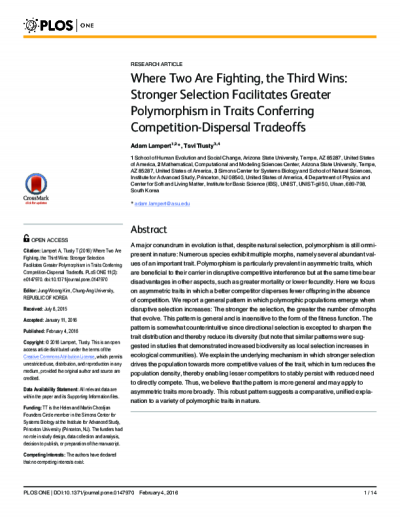Mathematical Modeling of Infectious Diseases

- Author (aut): Yamamoto, Nao
- Thesis advisor (ths): Wang, Haiyan
- Thesis advisor (ths): Lampert, Adam
- Committee member: Jehn, Megan
- Publisher (pbl): Arizona State University





A major conundrum in evolution is that, despite natural selection, polymorphism is still omnipresent in nature: Numerous species exhibit multiple morphs, namely several abundant values of an important trait. Polymorphism is particularly prevalent in asymmetric traits, which are beneficial to their carrier in disruptive competitive interference but at the same time bear disadvantages in other aspects, such as greater mortality or lower fecundity. Here we focus on asymmetric traits in which a better competitor disperses fewer offspring in the absence of competition. We report a general pattern in which polymorphic populations emerge when disruptive selection increases: The stronger the selection, the greater the number of morphs that evolve. This pattern is general and is insensitive to the form of the fitness function. The pattern is somewhat counterintuitive since directional selection is excepted to sharpen the trait distribution and thereby reduce its diversity (but note that similar patterns were suggested in studies that demonstrated increased biodiversity as local selection increases in ecological communities). We explain the underlying mechanism in which stronger selection drives the population towards more competitive values of the trait, which in turn reduces the population density, thereby enabling lesser competitors to stably persist with reduced need to directly compete. Thus, we believe that the pattern is more general and may apply to asymmetric traits more broadly. This robust pattern suggests a comparative, unified explanation to a variety of polymorphic traits in nature.